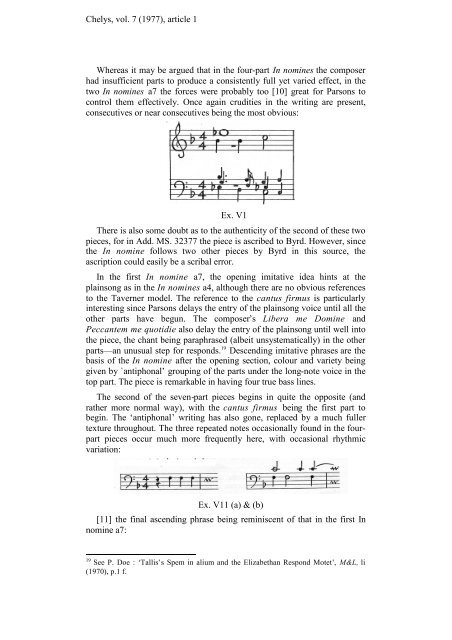download.pdf - 6.3Mb - Viola da Gamba Society
download.pdf - 6.3Mb - Viola da Gamba Society
download.pdf - 6.3Mb - Viola da Gamba Society
Create successful ePaper yourself
Turn your PDF publications into a flip-book with our unique Google optimized e-Paper software.
Chelys, vol. 7 (1977), article 1<br />
Whereas it may be argued that in the four-part In nomines the composer<br />
had insufficient parts to produce a consistently full yet varied effect, in the<br />
two In nomines a7 the forces were probably too [10] great for Parsons to<br />
control them effectively. Once again crudities in the writing are present,<br />
consecutives or near consecutives being the most obvious:<br />
Ex. V1<br />
There is also some doubt as to the authenticity of the second of these two<br />
pieces, for in Add. MS. 32377 the piece is ascribed to Byrd. However, since<br />
the In nomine follows two other pieces by Byrd in this source, the<br />
ascription could easily be a scribal error.<br />
In the first In nomine a7, the opening imitative idea hints at the<br />
plainsong as in the In nomines a4, although there are no obvious references<br />
to the Taverner model. The reference to the cantus firmus is particularly<br />
interesting since Parsons delays the entry of the plainsong voice until all the<br />
other parts have begun. The composer’s Libera me Domine and<br />
Peccantem me quotidie also delay the entry of the plainsong until well into<br />
the piece, the chant being paraphrased (albeit unsystematically) in the other<br />
parts—an unusual step for responds. 19 Descending imitative phrases are the<br />
basis of the In nomine after the opening section, colour and variety being<br />
given by `antiphonal’ grouping of the parts under the long-note voice in the<br />
top part. The piece is remarkable in having four true bass lines.<br />
The second of the seven-part pieces begins in quite the opposite (and<br />
rather more normal way), with the cantus firmus being the first part to<br />
begin. The ‘antiphonal’ writing has also gone, replaced by a much fuller<br />
texture throughout. The three repeated notes occasionally found in the fourpart<br />
pieces occur much more frequently here, with occasional rhythmic<br />
variation:<br />
Ex. V11 (a) & (b)<br />
[11] the final ascending phrase being reminiscent of that in the first In<br />
nomine a7:<br />
19 See P. Doe : ‘Tallis’s Spem in alium and the Elizabethan Respond Motet’, M&L, li<br />
(1970), p.1 f.
















